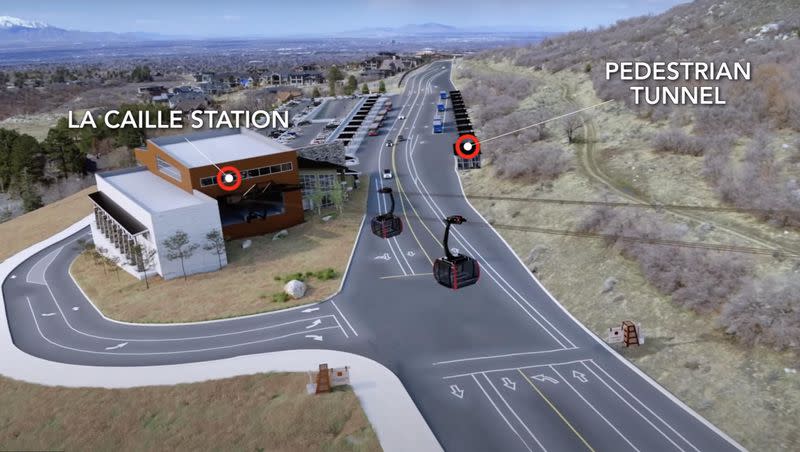Opinion: The gondola would destroy the Central Wasatch mountains

The Central Wasatch Mountains are a treasure for the region, offering a spectacular setting for our urban area, unparalleled recreational access, and a watershed and environment sustaining core needs for millions of residents and visitors. A gondola slicing through Little Cottonwood Canyon (LCC) — as proposed by the Utah Department of Transportation (UDOT) and the ski areas — would have horrible impacts on this treasured resource, and would serve as only a partial, expensive solution to its transportation challenges.
As proposed, this would be the longest gondola in the world, running non-stop (point-to-point) from the mouth of LCC to Snowbird and Alta ski resorts. It would not stop at trailheads or other destinations favored by visitors to the canyon.
UDOT’s analysis of the benefits and impacts of a gondola, selling it as a sexy cable ride up the beautiful canyon, is narrow and ill-considered. In fact, the gondola would make conditions in and adjacent to the Central Wasatch worse for anyone who is not sitting in a gondola car.
Even the experience of getting to the gondola base station would be unpleasant. Visitors to the canyon would have to drive to a massive parking structure and walk or bus a long distance with ski equipment to stand in line for the gondola. Once they finally board, they would arrive an hour later at Snowbird with further delays before going to Alta.
Related
Instead of replacing the crush of vehicles in the canyon with a year-round system that gets all or most cars off the road, the gondola would operate only in winter, reducing traffic by only 30% for part of the year. New road development, including avalanche sheds, road widening, and parking facilities, would be required for construction access and to evacuate people during emergencies.
Besides its questionable transportation benefits, the gondola’s impacts on non-resort visitors to the canyon will be staggering. These include potentially irreparable harm to the watershed according to those responsible for our water supplies; visual blight from the massive 200+foot towers, cable cars, and nighttime lighting; and increased traffic density in canyon-mouth communities already overwhelmed with vehicular congestion.
In short, the character of Little Cottonwood Canyon would forever be compromised, while unacceptable road conditions continue.
After more than 30 years of studying and searching for transportation solutions in the Central Wasatch, three alternatives have emerged and remain on the table: increased bus service, a gondola and trains. While no solution is perfect, and each has its advantages and disadvantages, the 2015 Mountain Accord, refined by the Central Wasatch Commission “Pillars”, offers an instructive framework that includes five principles for identifying a transportation solution:
Protect the watershed
Address increased visitor use impacts
Implement traffic demand, parking, bus and other transit strategies
Integrate solutions into the broader regional transportation network
Provide year-round transit service
Better protect the Wasatch Mountains through federal lands action
Related
Opinion: Why spend more than $500M on a gondola when this option exists?
Inside the faith-based argument against developing Little Cottonwood Canyon
The gondola meets none of these consensus principles for a transportation solution. It is designed for one user group — resort skiers — and it fails to consider a comprehensive approach to transportation throughout the Wasatch Mountains and Salt Lake Valley.
The Environmental Impact Statement UDOT prepared for LCC is inadequate on several fronts, and it does not serve the public or the mountains’ transportation challenges. While its process for seeking input was robust — requesting, receiving and categorizing more than 13,000 comments — meaningful public engagement must go further.
Local governments, private canyon stakeholders from the profit and nonprofit sectors, landowners, and the public should be integrally involved in the discussions and search for solutions. Such engagement can lead to a common understanding of the larger impacts and public sentiment about the possible solutions. It is noteworthy that the gondola is opposed by the mayors of every directly affected local government (Sandy, Salt Lake City, Salt Lake County, Cottonwood Heights, and Alta Town), every conservation group, and a majority of the public commenters. Also noteworthy, and somewhat inexplicable, is UDOT’s failure to consider trains as a viable solution.
The proposed gondola follows a series of disastrous, failed proposals for our mountains: SkiLink, Interconnect/One Wasatch and large surface mining. It pains me, after spending 50 years in the Wasatch Mountains as a recreational user, consultant to governments, and elected official, to see our state transportation department join the parade of these ill-conceived proposals.
If the Central Wasatch Mountains were a National Park, it would be the third most visited National Park in the nation. Why create a Disneyland experience for a very few, while destroying the mountains that so many of us enjoy? State appropriations should create short-term, relatively inexpensive improvements and find real, effective transportation solutions for our mountains and its users.
Ralph Becker is former Salt Lake City Mayor (2008-2015), Executive Director of the Central Wasatch Commission (2018-2022), Utah House of Representatives Member (1997-2008) and consultant at Bear West (1985-2007).

